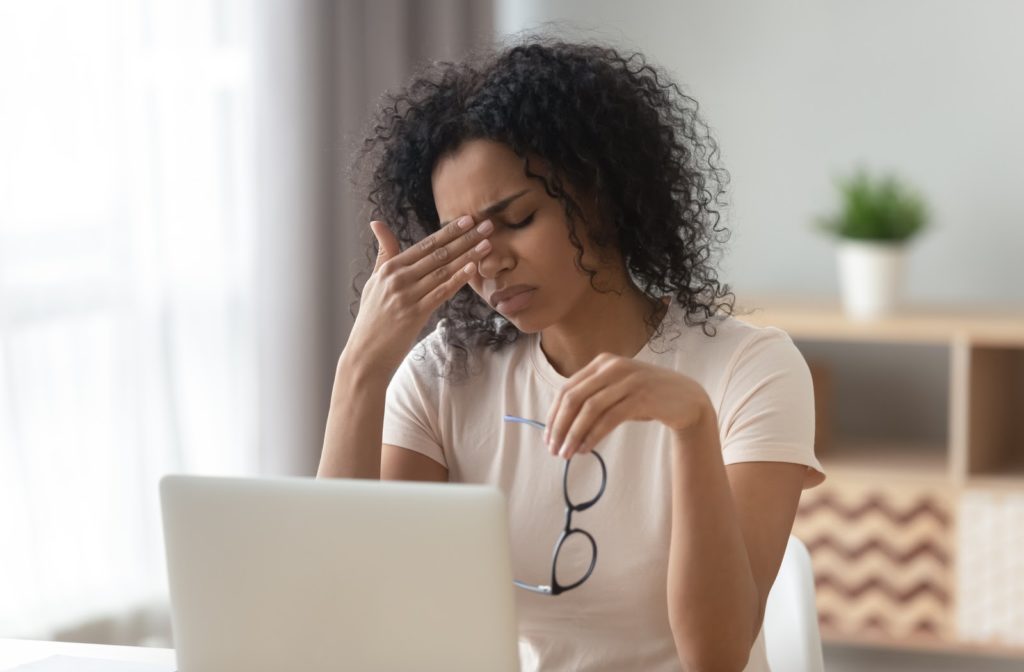Do you ever feel discomfort or fatigue after a long session on your laptop? Are your eyes dry and tearing up? Blurred vision?
You may be feeling the effects of digital eye strain, a syndrome common to many people who spend lots of time on their computer or cell phone. This condition can be properly diagnosed and corrected by an optometrist, with some easy to follow guidelines. Learn how to stay passionate about your work without the hindrance of tired, sore eyes.
What is Computer Vision Syndrome?
Computer vision syndrome (CVS), also known as digital eye strain, is an eye condition resulting from over exposure to digital screens. This includes desktop computers, laptops, cell phones, tablets, e-readers, and any other electronic device that uses backlighting to display an image. The average American spends over 6 hours a day staring at digital screens. As mobile devices become more integrated in our lives, we must be conscious about the effect this has on our visual health.
Symptoms of Computer Vision Syndrome
The following list contains many of the symptoms known to be associated with CVS. Symptoms are believed to be more abundant after prolonged sessions in front of a screen. If you experience any of these feelings after long periods with a computer or mobile device, consider calling an eye care professional.
- Dry eyes
- Eye strain
- Headaches
- Neck or back pain
- Blurry vision
- Eye fatigue
Prepare Your Eyes for Success
Many of us must cope with the reality that cell phones and computers are part of everyday life, be it for work or fun. But some of the problems with staring at screens can be mitigated. With the right preparation and the right eyewear, you can help your eyes conquer visual discomfort.
Wear Blue Light Glasses
Did you know there are special lenses that combat digital eye strain? They’re called Blue LIght Lenses, and studies have shown a decrease in CVS for people who wear them.
Most digital screens emit a high level of blue lightwaves, which can have adverse effects on health and sleeping patterns. Blue light glasses are manufactured with a special coating to purposefully block this harmful blue light. Whether you have a strong prescription, or require a neutral lens, go with Blue Light Glasses to overcome computer vision syndrome.
Finetune Your Focus
CVS can be exaggerated with the presence of the eye condition presbyopia. Presbyopia is the loss of ability to focus on nearby objects. This commonly occurs as people age, and can be a major problem when working for long hours on a computer.
Task specific multifocals remedy this issue. These are glasses with progressive lenses that account for consistent use in front of a screen, without sacrificing your other visual needs. Invest in eyewear that is specifically designed to focus on a computer if you find yourself experiencing symptoms of digital eye strain.
Say Goodbye to Dry Eyes
Some people are prone to dry eyes, and this will be accentuated during long digital sessions. There are several methods that an eye care professional can recommend when identifying your own dry eye issues. But there are some simple do-it-yourself activities to cope with dry eyes too:
- Blink often
- Avoid smoke
- Get a humidifier for rooms you work in
- Use preservative-free eye drops
Never over-wear your contact lenses or extend use beyond professional recommendations. Always take your contact lenses out at night and ensure proper cleaning. Consult your eye care professional for potential contact lens solutions that will help eliminate digital eye strain.
Tips & Tricks
Beyond having the proper eyewear, there are several ways you can help diminish the effects of digital eye strain. By modifying some typical behaviours associated with computer usage, you can lessen the negative impact of screens and devices.
20-20-20 Rule
The American Optometric Association recommends this simple and effective rule when spending long sessions on a digital device. It can be done in any setting and will lessen the strain on your eyes.
Every 20 minutes,
Take a 20 second break,
And look at something 20 feet away.
It’s that simple.
Perfect Your Posture
Maintaining healthy, ergonomic posture at your desk will definitely help curb CVS. Not only does great posture mean better circulation and blood flow to your eyes, but it provides health benefits beyond vision. Try sitting like this when at your desk or using a laptop computer. If you can’t comfortably see your screen from 20-25 inches, then it’s time for a new eye exam.
Optimize Your Device Settings
Most mobile devices and laptops have a “night time” setting that can be enabled. This will diminish the blue light being emitted from the device and lower the effects of digital eye strain. Use it!
Android users can follow instructions here to activate Night Mode.
Iphone users can use these instructions for activating Night Shift.
Try Using an E-Reader
In contrast to most mobile phones and all purpose tablets, an e-reader uses a monochrome display specifically designed for still text. These devices usually include edge lighting (as opposed to a backlit LCD display), which will reduce digital eye strain over long reading periods.
Computer vision syndrome is common for anyone that wakes up with their cell phone, works all day on their computer, and goes home to play on their tablet. Managing CVS effectively is what will sustain long term visual health and prevent more serious ocular conditions. And every once and awhile, just pick up a good ol fashioned book!




